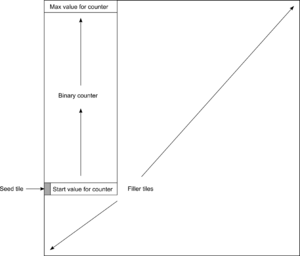Difference between revisions of "Facet Error Handling"
| (2 intermediate revisions by the same user not shown) | |||
| Line 27: | Line 27: | ||
</references> | </references> | ||
| − | [[Category: kTAM | + | [[Category:kTAM Results]] |
| + | [[Category:Self-assembly]] | ||
Latest revision as of 15:13, 27 May 2014
In [1], the proofreading technique previously discussed was sufficient to reduce growth errors, but was ineffective for handling facet errors. These types of errors were more common in systems "whose growth process[es] intrinsically involve facets", meaning that they frequently require growth to be initiated by extending from a flat surface. In order to reduce these errors, Winfree and Bekbolatov were able to redesign a system used to build an n × n square by changing the pattern of growth to one which avoids large facets. Specifically, the design used to build the square in Figure 1 (below) was redesigned so that, instead of using a single binary counter growing along one side and then filler tiles which are dependent upon facet growth, two binary counters were used used to form two sides of the square and then filler tiles which use cooperative attachments between those walls. These modifications (along with a few other small changes) were able to greatly reduce the incidence of errors in the growth of squares.
References
- ↑
Erik Winfree, Renat Bekbolatov - Proofreading Tile Sets: Error Correction for Algorithmic Self-Assembly
